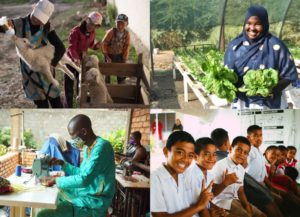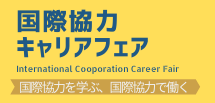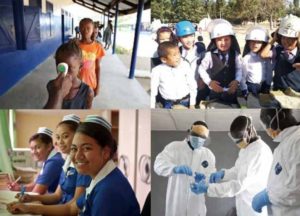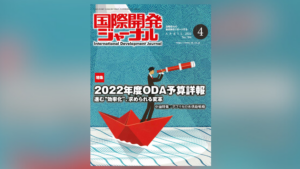IDJ-ENGLISH Fight aga-english
Fight against poverty under COVID: World Bank Vice President Aki Nishio elaborates on WBG strategies
 International Development Association (IDA) provides support to the world’s 74 poorest countries. IDA20 was advanced by one year, and at the final meeting held in December 2021, development partners agreed on a historic $93 billion financing package to help countries recover from the COVID-19 crisis and build societies adapting to climate change. To learn about IDA and the World Bank Group’s challenges going forward, we interviewed Vice President Akihiko Nishio, who led the IDA20 replenishment negotiations.
International Development Association (IDA) provides support to the world’s 74 poorest countries. IDA20 was advanced by one year, and at the final meeting held in December 2021, development partners agreed on a historic $93 billion financing package to help countries recover from the COVID-19 crisis and build societies adapting to climate change. To learn about IDA and the World Bank Group’s challenges going forward, we interviewed Vice President Akihiko Nishio, who led the IDA20 replenishment negotiations.
By Mitsuya Araki, Editor-in-chief of International Development Journal (IDJ)
Focus on “Human Capital” among others as priority themes
――Tell us about your career.
I worked for Overseas Economic Cooperation Fund (OECF) before joining the World Bank in 1988 through the Young Professional Program. Since then, I held diverse positions across the institution, including taking part in IDA15 replenishment exercise in 2007. As Director for Strategy and Operations for Equitable Growth, Finance and Institutions (EFI), I managed several thousands of staff. In 2019, I assumed the Development Finance (DFi) vice presidency, which used to be assumed by someone with an European origin. I led both IDA19 and IDA 20, which, in total, mobilized nearly 20 trillion yen (USD 175 billion).
――Give us a sense of the the World Bank strategy going forward.
We have come up with a Green, Resilient and Inclusive Development (GRID) approach, with the view to providing support to developing countries whose economies are severely damaged by the pandemic, as they are most likely to miss the poverty reduction target set by the Sustainable Development Goals or SDGs. Our aim is to realize a swift recovery that is green and highly resilient to future crises that benefits not only the advantaged but also the entire population. IDA20 replenishment is aligned with this approach.
IDA20 has adopted “climate change,” “fragility, conflict and violence (FCV),” “gender,” and “job and economic transformation,” and “human capital” as special themes. Human capital covers issues as COVID19 vaccination rollout and building resilient healthcare systems.
Increasing presence of Asia as donors
――Share with us your perspectives on Asia.
East Asia has achieved steady economic development over a sustained period, and has outperformed other regions. Most successful countries, such as the Philippines, Thailand, and Malaysia, have even become donors to IDA. Thailand, in particular, has considerably increased its contribution to IDA20.
Among South Asian countries, India graduated from IDA several years ago and is now an IDA donor. Pakistan still borrows from IDA but became a donor country several years ago, affirming that they would also like to contribute to IDA.
While the United States and European countries still hold a major presence among IDA donors, Asian countries have increased their presence. Japan has been a major donor since IDA’s establishment in 1960, and China and Korea, both initially borrowers, have become major donors by now.
However, we should not be complacent. Many countries in the East Asia region are heavily dependent on China economically, and thus vulnerable to the slowdown of Chinese economy. Added to this is the disruption of supply chains under the pandemic, resulting in constrained growth.
In South Asia, division among countries poses major economic challenges. Given political and historical challenges, economic and people-to-people interactions are anemic among these countries. If the region holds together as a single market, it has the capacity to demonstrate great competitiveness. If India, Pakistan, and Nepal can work together, for example, they have the potential to generate huge hydroelectric power, with the capacity of building a cross-border power grid in the region. However, the decoupled relationships among the countries are not making such regional cooperation possible.
――How about Myanmar?
Operations in Myanmar have been suspended. However, our Country Director remains in Yangon, and we are continuing our engagement with other aid agencies and donor countries in the field on how to support the poorest people.
Africa’s challenges: human capital and connectivity
――Tokyo International Conference on African Development (TICAD 8) is scheduled to take place this year. How will WBG support to Africa look like going forward?
The World Bank
Akihiko Nishio, World Bank Vice President of Development Finance (DFi)
In Africa, deficits in human capital are more acute than in other regions. Human Capital Index clearly stands very low in Africa. The World Bank therefore aims to focus on education, health, and nutrition.
In addition, for more than a decade, the World Bank has been working hard on regional projects that connect multiple countries. There are many regional integration projects, including cross-country highways and power projects that come along with enhanced grid connections. With many landlocked and small states, Africa is yet to be fully integrated as a single market. While Africa has put in place the African Continental Free Trade Area (AfCFTA) since January 2021, it remains fragmented, and more needs to be done to strengthen the connectivity.
Yet another immediate challenge is to boost COVID vaccinations. In Africa, vaccination ratio remains less than 4% of the total population. The World Bank, World Health Organization (WHO), COVAX and other institutions need to come together to address the challenge.
Let me also underscore that the World Bank is stepping up adaptation finance in Africa and beyond, including by providing support in agricultural area and others.
Expectation for Japan: a more active role in drawing up country-level development strategies
――Any advice/suggestions to Japan’s aid?
Japan’s aid is appreciated. In my view, this can be attributed to o Japan’s sustained commitment to the long-term development of developing countries, which is underpinned by Japan’s knowledge and expertise. Of particular note is Japan’s expertise on disaster risk management, which has been harnessed elsewhere.
Japan has also been a leader in the area of nutrition. The COVID-19 pandemic has disrupted food supply chains, posing serious challenges from food insecurity. But this is a chronic issue, as malnutrition among children has been an issue for decades in many low-income countries. Japan has played a leading role in the international community, including by hosting the Tokyo Nutrition for Growth (N4G) Summit in December 2021.
Another topic that Japan has been focusing on is the “Universal Health Coverage (UHC)” whose goal is to ensure that everyone can access basic health services at affordable cost. COVID has been a reminder call that achieving UHC is critically important. This is yet another example where Japan’s long-standing efforts are highly appreciated.
Also, in the IDA20 replenishment, the Government of Japan has demonstrated outstanding leadership. Initially, most of the donor countries were reluctant to advance the replenishment given their tight fiscal constraints. Japan’s strong call to advance the replenishment by one year was deeply appreciated by recipient countries.
 Let me finally provide a personal suggestion to the Japanese aid community: deeper engagement with WBG country-strategies. The World Bank Group has started to work on Country Climate and Development Reports (CCDRs) to help countries align their climate actions and development efforts. If Japan could play a more active role in joining the discussion in the field, it would be appreciated. The World Bank prepares CCDRs for each client country, with inputs from donor countries and aid organizations. It would be great to see Japan play a more active role in shaping assistance strategies, drawing on its knowledge and expertise.
Let me finally provide a personal suggestion to the Japanese aid community: deeper engagement with WBG country-strategies. The World Bank Group has started to work on Country Climate and Development Reports (CCDRs) to help countries align their climate actions and development efforts. If Japan could play a more active role in joining the discussion in the field, it would be appreciated. The World Bank prepares CCDRs for each client country, with inputs from donor countries and aid organizations. It would be great to see Japan play a more active role in shaping assistance strategies, drawing on its knowledge and expertise.
RELATED
西尾昭彦 開発金融総局担当副総裁
西尾昭彦 世界銀行開発金融担当副総裁(IDA担当副総裁)関連ニュース・ブログ・イベント
*****以下、日本語原文*****
コロナ禍での貧困撲滅を目指す
西尾副総裁が語る世界銀行の開発戦略
最貧国 74 カ国への資金援助を行う世界銀行グループの国際開発協会(IDA:アイダ)。コロナ禍からの回復、そして気候変動に対応した社会づくりを後押しするべく、1 年間前倒しされた第 20 次増資交渉(IDA20)の最終会合が 2021 年 12 月に開催され、過去最大規模となる 930 億ドルの増資が合意された。今後、IDA を含め世界銀行グループはどのような支援を展開していくのか。IDA20 の増資交渉を担当した西尾昭彦副総裁に話を聞いた。(聞き手:本誌主幹・荒木 光弥)
「人的資本」などを重点課題に
――西尾副総裁のこれまでの経歴
を教えてください。
1988 年 に 海 外 経 済 協 力 基 金(OECF)からヤング・プロフェッショナル・プログラムを通じて世界銀行に入行した。さまざまな職を経験し、2007 年の IDA15 の増資交渉を担当したほか、公正成長・金融・制度(EFI)戦略業務局長として数千人の職員をまとめる経験もした。そして 19 年、従来は欧州出身者が担ってきた開発金融政策担当の副総裁に着任。IDA19 とIDA20 を合わせて、日本円で 20兆円近くの増資合意に携わった。
――世界銀行の今後の支援方針は。
環境に配慮した強靭で包摂的な開発(GRID)という方針を立てている。これは、コロナ禍で疲弊し経済も停滞する中、貧困撲滅
などの達成率が、持続的開発目標(SDGs)などに掲げられている目標を大幅に下回りそうな途上国に対する支援方針である。環境に配慮し、将来の危機に対して強靭な対応力を持ち、エリート層だけでなく国民全体に裨益するような回復の迅速な実現を目指す。IDA20の増資も同方針に基づく。
IDA20 は特別重点課題(special themes)として、「気候変動」「脆弱性・紛争・暴力(FCV)」「ジェンダー」「雇用と経済改革(JET)」「人的資本」を設けた。人的資本ではコロナワクチン投与や、保健衛生システム強化もカバーする。
ドナーとしての存在感増すアジア
――地域展望として、アジアはど
のように見ていますか。
東アジアは中長期でみると順調な経済発展を遂げており、開発途上国の中では非常にパフォーマンスの良い国が多い。特にフィリピン、タイ、マレーシアなどは順調に成長しており、IDA ドナー国ともなっている。中でもタイは今回、拠出額を大幅に増やした。
南アジア諸国でも、インドが数年前に IDA の支援対象国から卒業し、IDA ドナー国となった。パキスタンは今も IDA から借り入れを受けているが、数年前からはIDA に貢献したいという意向からIDA ドナー国にもなっている。
依然、IDA ドナー国の中では欧米諸国の存在感は大きいが、アジア諸国の勢いも増している。日本は 1960 年に IDA 創設以来の主要ドナーであり、当初借入国だった中国と韓国も今や大口ドナー国だ。
他方、懸念もある。東アジア地域では中国への経済的依存度が高い国が多く、中国経済の減速に大きな影響を受けることや、コロナ禍によるサプライチェーンの分断が成長の足枷となっていることだ。
南アジア地域については、各国間の分断が大きな経済的課題だ。政治・歴史的な背景で、国同士の経済・人的交流が少ない。本来、同地域は一つの市場としてまとまれば大きな力を発揮できる。例えばインド、パキスタン、ネパールの3国が協力すれば水力発電で膨大な電力を生み出すポテンシャルがある。これを利用すれば国境を跨ぐ地域電力網の構築も可能だが、各国の関係が分断されている中ではそうした地域内協力の支援もなかなか実現できないでいる。
――ミャンマーについては。
ミャンマーへの新規貸付は、現在、控えている。だが担当局長は引き続きヤンゴンに滞在しており、最貧層の人達をどう支援すべきか、他の援助機関やドナー各国と協議している。
アフリカの課題は人材と連結性
――今年は第8回アフリカ開発会議
(TICAD 8)の開催も予定されています。アフリカ地域にはどのような支援に注力していきますか。アフリカは他の地域に比べて、人的資本の薄さが顕著だ。人的資本指標を見るとアフリカの水準が低いのが目立つ。このため世界銀行としては教育、保健衛生、栄養などの支援に注力したい。このほか、世界銀行が 10 年以上前から力を入れているのが、複数の国をつなぐ地域対象プロジェクトだ。数カ国に跨る道路の建設、数カ国に送電線で配電する電力プロジェクトなど、国と国をつなげるプロジェクトを多く手がけている。アフリカは内陸国や小国が多く、一つの市場として十分まとまっていない。2021 年1月にアフリカ大陸自由貿易圏(AfCFTA)が始動するなど、法整備も進んでいるが、依然として経済が細分化されており、連結性の強化は不可欠だ。
ワクチン投与率の向上も、喫緊の課題だ。アフリカのワクチン接種率は全人口の4%未満。世界銀行、世界保健機関(WHO)、COVAX など関係組織が協力し取り組みを推進する必要がある。また、アフリカ地域に限った話ではないが、農業支援などで気候変動への適応を重視している。
――日本の政府開発援助(ODA)への期待、提言はありますか。
日本の ODA は各国から非常に好意的に受け止められている。途上国と持続的に向き合い、長期間援助を行っていることや日本の経験・知見を生かした支援を行っていることが、その要因だと思う。中でも日本の防災に関する知見は、各国で大いに参考にされている。また、栄養の分野でも日本はリーダーシップをとっている。新型コロナウイルスの流行でフードサプライチェーンが分断され、食料不足が大きな問題となっている。だが、多くの低所得国では子供の栄養不足は数十年前からの課題だ。2021 年 12 月に東京栄養サミットを開催するなど、積極的に発信をしてきた日本の役割は大きい。また、全ての人が基礎的な保健医療サービスを支払い可能な費用で受けられるようにする「ユニバーサル・ヘルス・カバレッジ」(UHC)の推進は、日本が力を入れてきた分野だ。コロナ禍でその必要性が広く痛感され、かねてから問題に取り組んできたことが高く評価されているように思う。
IDA20 の増資交渉においても、日本政府はリーダーシップを発揮してくれた。ほとんどのドナー国が厳しい財政事情のため前倒し増資に難色を示した中で、今だからこそやるべきだと呼びかけリーダーシップを取ってくれた日本に対し、途上国は大変感謝している。日本の ODA に対する提言としては、強いて言えば、各国への開発協力の戦略作りにもっと参加してもらえると心強い。例えば、世界銀行は気候変動への対応と経済開発の支援に同時に取り組んでいくため、国別気候・開発報告書(CCDR)の作成を開始した。
ここにぜひ日本も積極的に参加していただければと考えている。各国の CCDR は世界銀行が作成しているが、ドナー国や援助機関にもアドバイスをもらっている。日本にも、その知見や技術を存分に発揮していただきながら、新しい時代の経済開発の支援方針策定に参加してもらえたら嬉しい。
『国際開発ジャーナル誌』 2022年 3月号掲載




